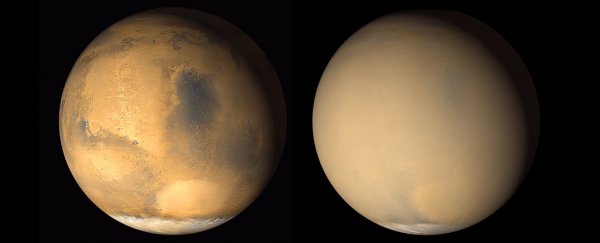The surface of Mars is dry and arid now, but scientists suspect that wasn't always the case – which raises the question of where all that water went. A new study suggests huge dust storms played a role in whipping all the moisture out of the Martian atmosphere.
Based on an analysis of a major dust storm that hit the Red Planet in 2007, courtesy of NASA's Mars Reconnaissance Orbiter (MRO), scientists think the storms help hydrogen gas -produced from rising water vapour - to escape from the atmosphere.
And now the team of researchers is hoping for another big dust storm to gather on Mars again this year. We've got more satellites and probes trained on the planet than ever before, so such a meteorological event could provide us with even more useful data.
"We found there's an increase in water vapour in the middle atmosphere in connection with dust storms," says one of the scientists, Nicholas Heavens from Hampton University in Virginia. "Water vapour is carried up with the same air mass rising with the dust."
Deep convection is thought to be the process at play, something we also see on Earth as different layers of air reach different temperatures, causing the movement of gases and aerosols – in this case, perhaps, lifting water and ice away from Mars' surface where it disintegrates into smaller components as it heads towards space.
Thanks to measurements taken by the Mars Atmosphere and Volatile Evolution mission (MAVEN) probe, experts have already noticed the way hydrogen can be lost through the skies of Mars.
The process happens as water molecules in the middle atmosphere (from around 50-100 kilometres or 31-62 miles up) get broken apart by sunlight into hydrogen and oxygen atoms, with the hydrogen then carried out into space by solar winds.
However, the pattern of hydrogen escaping varies a lot over the year. Scientists aren't sure why, which is where the new study comes in – could dust storms be responsible for lifting water vapour from the lower atmosphere into the middle atmosphere?
Using an instrument on board the MRO called the Mars Climate Sounder (MCS), the team was able to gauge temperature, pressure, dust, and water ice opacity on the planet.
Sure enough, there was a link between "dust flux" (dust storm activity) and hydrogen escape rates. Small dust storms appeared to increase the amount of water vapour in the middle atmosphere, while the major storm of 2007 showed a sharp jump in the altitude the water vapour reached.
In fact there was more than a hundred times the amount of water vapour in the middle atmosphere than normal during that last huge dust storm.
While the calculations include some estimations, and peering back billions of years involves even more educated guesswork, the results here suggest past storms could have accelerated the process of moving water up to the higher atmosphere.
"What would the climate have been like when the atmosphere was thicker?" says one of the researchers, Michael Chaffin from the University of Colorado Boulder. "Perhaps not as dry, but perhaps windier."
"We can't really say whether there would have been more dust storms or what their effect on loss of gas from the atmosphere would have been during those earlier conditions. A good way to improve our understanding about dust storms on ancient Mars would be to get more observations during a global dust storm on today's Mars."
A lot of factors are at play here, and this is only one part of the equation. Water loss on Mars has previously been attributed to solar winds clearing out the Martian atmosphere, with the help of a twisting magnetic tail.
Now all eyes are on Mars to see if we'll get another global dust storm darkening the skies of the Red Planet – we'll be able to see how the water vapour and hydrogen loss rates are affected, and potentially collect some vital clues into Mars' past.
Based on the pattern of past storms that have grown to cover the planet in 1977, 1982, 1994, 2001, and 2007, scientists are predicting another one is due this year.
"It would not be a surprise to see a global dust storm this year, and we would love that opportunity," says Bruce Jakosky from the University of Colorado Boulder, who wasn't involved in this new study but works on NASA's MAVEN mission.
The research has been published in Nature Astronomy.
